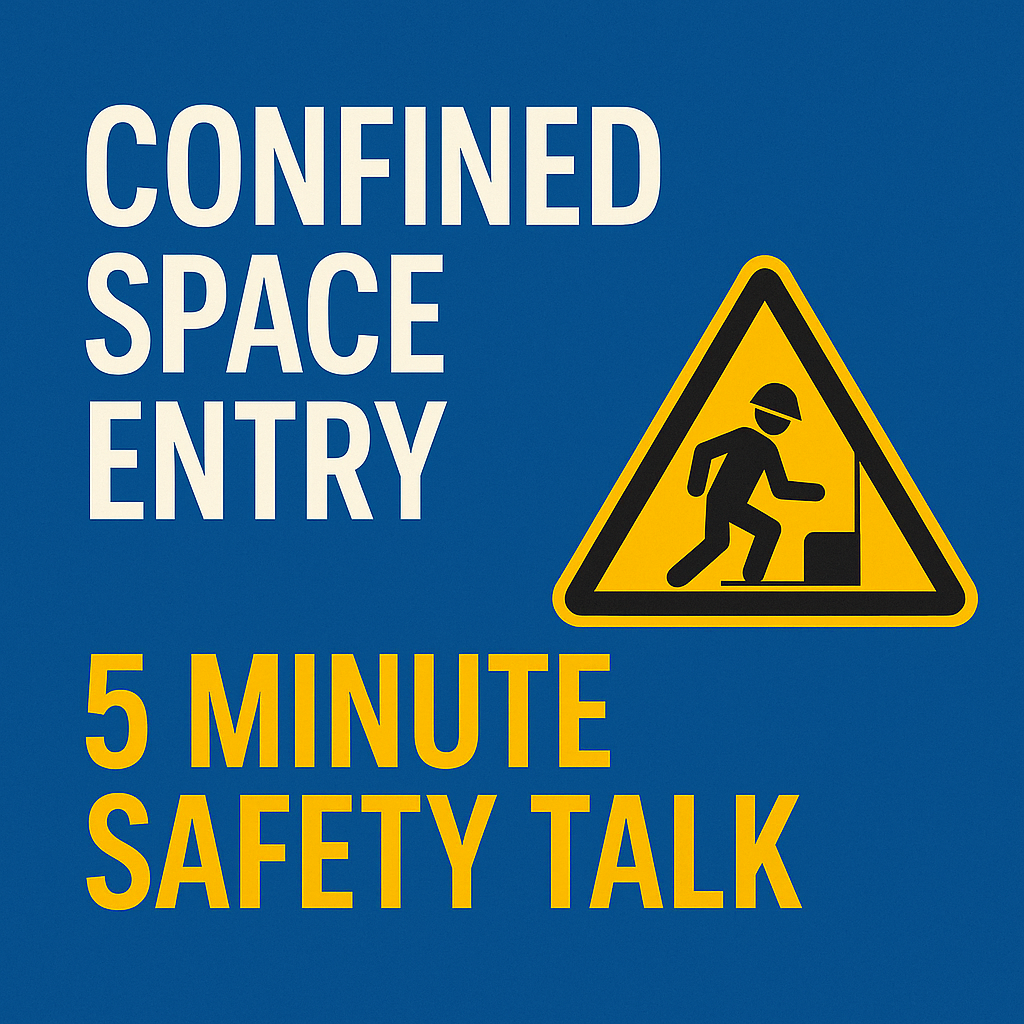
Confined Space Entry 5 Minute Safety Talk
Good Morning Team,
Today, we’re focusing on a topic that’s critical—and potentially deadly if not handled right: Confined Space Entry.
Confined spaces may look harmless, but they can be silent killers. Why? Because dangers such as lack of oxygen, toxic gases, engulfment, or unexpected movement of equipment can turn a normal task into a life-threatening emergency in seconds.
So, let’s take five minutes to refresh ourselves on how to stay safe when working in or around confined spaces.
What is a Confined Space?
A confined space is any space that:
- Is large enough for a person to enter and perform tasks
- Has limited entry or exit
- Is not designed for continuous occupancy
Examples include:
- Tanks
- Pits
- Silos
- Vessels
- Sewers
- Underground utility vaults
Why Are Confined Spaces So Dangerous?
Here are the main hazards:
- Lack of oxygen – You can pass out in seconds
- Toxic or flammable gases – Invisible and deadly
- Engulfment – Loose materials like sand or grain can bury a person
- Temperature extremes – High heat or cold in tight areas
- Poor visibility and limited movement – Slows down escape or rescue
- Moving machinery – Augers, mixers, or agitators may start unexpectedly
Before You Enter – Pre-Entry Checklist
Before anyone enters a confined space, certain steps must be followed:
1. Permit-to-Work System
- Never enter without a valid permit
- Includes hazard assessment and emergency plan
2. Air Monitoring
- Test for oxygen level, toxic gases, and explosive gases
- Use a calibrated gas detector and test continuously
3. Ventilation
- Ensure fresh air circulation
- Use blowers or fans if natural ventilation is inadequate
4. Isolation of Energy Sources
- Lockout/Tagout all machinery and valves
- Ensure no accidental energization
5. PPE and Safety Gear
- Helmet, gloves, boots
- Harness and lifeline for rescue
- SCBA or respirators if hazardous atmosphere
Standby Person – The Lifeline Outside
Every confined space entry must have a trained standby person who:
- Remains outside the space
- Maintains constant communication
- Monitors the entrant’s status
- Initiates rescue procedures if needed
- Never enters the space themselves during an emergency unless trained and equipped
Emergency Rescue Plan
No job should begin without a detailed rescue plan in place.
- Practice mock rescues regularly
- Ensure rescue equipment is ready
- Inform local emergency services if required
- Identify nearest hospital in case of exposure
Real-World Example
A worker entered a storage tank to clean it without proper air monitoring. Within minutes, he collapsed due to oxygen deficiency. A second worker, trying to save him, also entered without PPE—and both died. A simple gas test and rescue harness could have saved them.
Summary – What You Should Now Know
- Confined spaces are high-risk—treat them with respect
- Always follow the permit system
- Monitor air quality constantly
- Use proper PPE and rescue equipment
- Never work alone—a standby person is essential
- Training saves lives
Noise Hazards and Hearing Protection 5 Minute Safety Talk
First Aid Awareness 5 Minute Safety Talk
Emergency Evacuation Procedures 5 Minute Safety Talk
Ladder Safety 5 Minute Safety Talk
Manual Handling 5 Minute Safety Talk
5 Unique FAQs
Q1: Can I enter a confined space without a permit if it seems safe?
No. Permits are mandatory to ensure all hazards are controlled.
Q2: How often should air be monitored inside confined spaces?
Continuously. Gases can accumulate or deplete oxygen at any time.
Q3: Who can be a standby person?
Someone trained in confined space procedures and rescue, who remains outside and alert.
Q4: What’s the minimum oxygen level for safe entry?
At least 19.5% oxygen is required. Anything less is unsafe.
Q5: Is ventilation always necessary?
Yes, especially in spaces with poor airflow or gas build-up risk. Ventilation is your first line of defense.